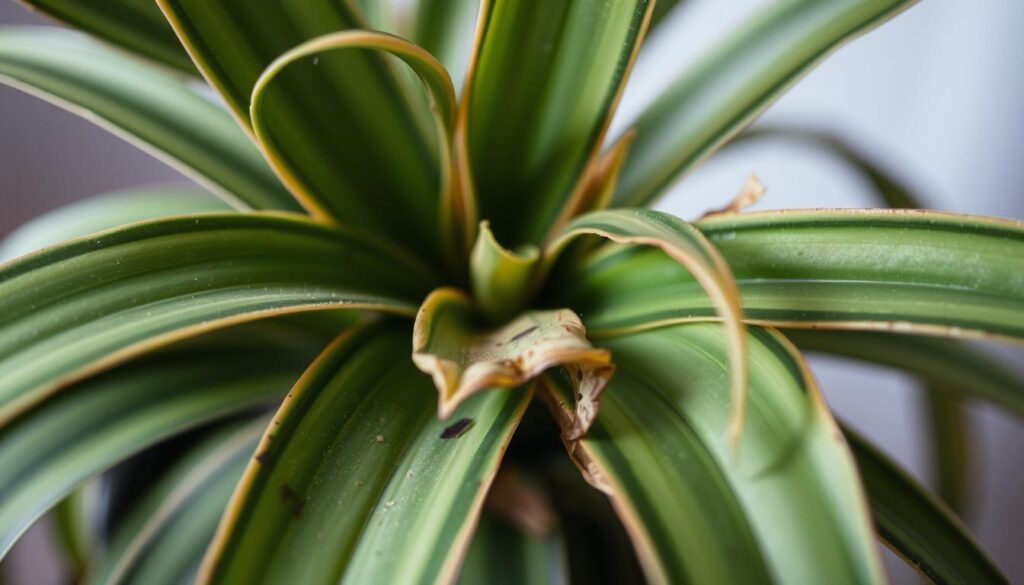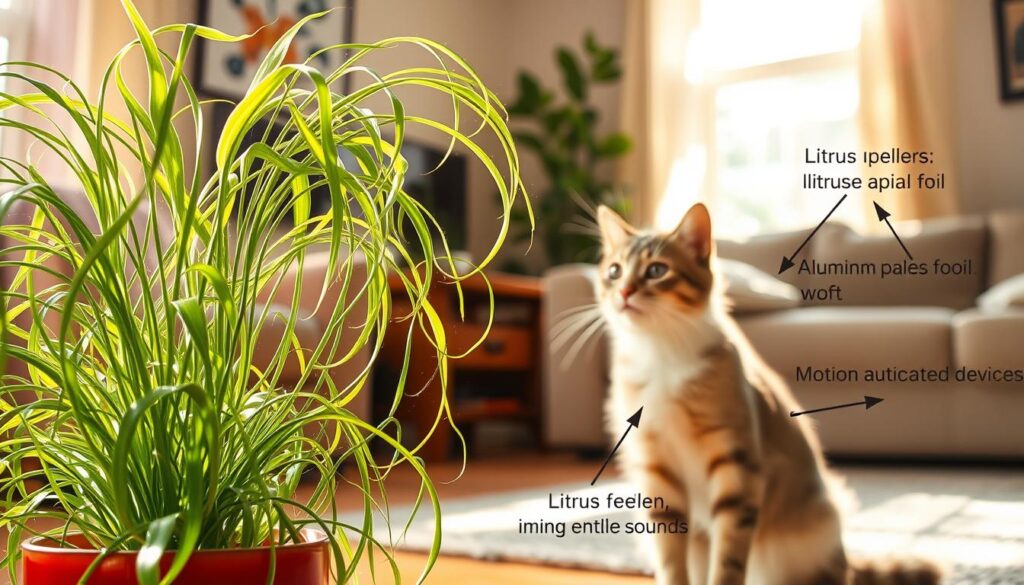I still remember the first time my tabby nosed a hanging pot and left a trail of soil across the floor. That small, curious act sparked a worry I know many pet owners feel: could my greenery harm my pet?
This guide explains how plant safety and pet care meet in today’s homes. The ASPCA lists Chlorophytum comosum as non-toxic to cats and dogs, yet eating any houseplant can upset a stomach if enough is consumed.
You’ll learn why felines often chew and bat at dangling offsets, when mild gastrointestinal symptoms may appear, and the simple steps to protect curious mouths. Expect clear advice on monitoring, when to call a veterinarian, and practical prevention: hanging pots higher, pruning temptations, and offering safe greens like cat grass.
Key Takeaways
- Spider Plants And Cats are generally safe; serious toxicity is rare.
- Ingestion can still cause mild vomiting or diarrhea in pets.
- Watch for symptoms, remove access, and contact your vet if they worsen.
- Use deterrents and safer companion greenery to reduce nibbling.
- Identify every species in your home so you can report it quickly to a vet.
Are Spider Plants Toxic to Cats Today? What the ASPCA and Experts Say
Authoritative sources list the common house specimen as non-toxic to household pets, yet nibbling can still cause trouble.
The ASPCA confirms the spider plant is not poisonous for cats or dogs. The Spruce echoes that view but warns that large amounts of foliage may lead to mild GI upset or vomiting. Non-toxic does not mean edible.
Quick takeaway: Non-toxic but not a snack—why mild GI upset can still happen
Cats are not built to digest lots of green matter. Eating too much leaf material can irritate the gut and cause brief symptoms like vomiting, loose stools, or reduced appetite.
- If your cat chews: remove access and watch closely for symptoms.
- Note details: record timing and amount eaten before calling a vet.
- Call your vet: if signs are severe, continue, or you suspect other toxic plants were involved.
| Status | Likely reaction | Recommended action |
|---|---|---|
| Non-toxic house green | Mild GI upset if overeaten | Remove access, monitor 24 hours |
| Unknown species | Possible severe toxicity | Contact vet with plant ID |
| Large quantity ingested | Persistent vomiting or lethargy | Seek veterinary care |
Bottom line: the plant’s non-toxic status is reassur ing, but keep foliage out of reach in busy homes. Proper placement and quick observation are the best defenses against needless gastrointestinal distress.
Spider Plants And Cats: Why the Attraction and What It Means
The long, arching leaves and dangling offshoots turn this popular hanging specimen into a built-in toy for playful pets.
Chlorophytum comosum basics: This trailing houseplant has arching foliage, long runners, and small baby offshoots called spiderettes. When hung, the moving runners catch a pet’s eye and invite interaction.
Why movement and texture matter
The sway of leaves mimics prey or toys. Curious animals will bat at runners, jump, or chew tips for play. For many, the shape and motion are as tempting as a dangling wand toy.
Mild hallucinogenic reports and grazing instincts
Some sources suggest a catnip-like effect for certain felines, but this is not proven and should be treated as anecdotal. Other pets simply nibble greens to help pass hairballs or to satisfy a grazing urge.
Typical behaviors and what to do
Owners often see batting, repeated chewing, or attention-seeking around the pot. Energetic or multi-pet homes may increase this focus.
- Observe when the interest spikes—play times, boredom, or social competition.
- Trim long spiderettes to reduce motion that invites play.
- Offer safe greens or extra enrichment to redirect attention.
Potential Risks If Your Pet Nibbles: Symptoms, Timing, and Vet Guidance
Even non-poisonous foliage can upset a pet’s digestive tract if eaten in quantity. Small bites often cause short-lived issues, but larger amounts can lead to clear symptoms that need attention.
What you might see: brief upset stomach, soft stools or diarrhea, and occasional vomiting. Grazing behavior may continue for a few minutes after eating.
When to monitor at home versus call the vet
If your cat or dog is alert, drinking water, and active, you can watch them at home for 24 hours. Keep the animal calm and limit further access to the plant.
Contact your vet right away if symptoms include repeated vomiting, blood in stool, marked lethargy, loss of appetite, or abdominal pain. Also call if multiple types of plants might have been eaten.

Notes for dogs and other animals
Dogs and other pets show similar non-toxic status, but large intakes can irritate the stomach and cause vomiting or diarrhea. Senior or sensitive animals may react more strongly and should get earlier veterinary guidance.
“Non-toxic does not mean edible; monitor for GI signs and keep good plant ID records.”
- Document how much was eaten, which part of the plant, and when symptoms began.
- Wipe any debris from the mouth and offer fresh water; avoid rich treats that could worsen upset.
- Remove the plant to prevent repeat nibbling.
| Situation | Likely signs | Recommended action |
|---|---|---|
| Small nibble | Mild stomach upset, soft stool | Monitor 24 hours, keep water available |
| Large amount eaten | Vomiting, repeated diarrhea | Call vet, bring plant ID |
| High-risk animal (senior/ill) | Stronger or prolonged symptoms | Contact vet promptly |
Prevention That Works: Keeping Cats Away While Keeping Plants Healthy
A few smart tweaks at home stop most nibbling without stressing your greenery.
Place smart: use hanging planters or high shelves well away from furniture that gives an easy launch path. Keep pots off bookcases, armchairs, and window ledges so curious paws can’t reach leaves or runners.
Decrease temptation: prune long spiderettes and divide an overgrown specimen to shorten dangling parts. Regular trimming reduces movement that grabs attention and keeps the houseplant tidy.

Make safe greens available: grow cat grass trays or offer catnip so your pet can graze without harming foliage. These alternatives satisfy the chewing urge and protect your display plants.
- Try mild deterrents like bitter sprays or light neem/lemon scents; test on a small area first.
- Boost enrichment: rotate wand toys, puzzle feeders, and climbing posts to redirect batting behavior.
- Use lightweight netting or decorative cages where needed to create a physical barrier without blocking light.
Routine and rewards: play before meals, reward the desired behavior, and remove fallen leaves promptly. These steps balance plant health and pet safety so both can thrive at home. For more tips on keeping pets away from houseplants, see this helpful guide: how to keep cats away from.
Pet-Safe vs. Avoid: Houseplants to Pair With or Keep Separate
Mixing safe species with risky ones helps reduce accidental nibbling and keeps curious pets from testing every leaf.
Pet-friendly companions: consider African violet, Boston fern, orchids, bromeliads, Chinese money plant, prayer plant, Haworthia, Venus flytrap, and the tough Cast Iron plant for low-light spots. These houseplants pair well with spider plants for a cohesive, pet-conscious display.
Plants to avoid around dogs and cats: keep ZZ plant, English ivy, snake plant, pothos, lucky bamboo, Aloe, Alocasia, sago palm, tulips, daffodils, and poinsettia out of reach. Many of these contain calcium oxalates, saponins, or other compounds that irritate the mouth or gut.
- Group safe species together in accessible areas.
- Confine higher-risk houseplants to no-pet zones or behind barriers.
- Offer a small indoor grass pot to satisfy grazing instincts and cut interest in other foliage.
Tip: verify care labels before purchase and keep a short species list on the fridge for quick vet reference.
For a fuller guide to non-toxic choices, see this short list of cat-friendly houseplants.
Conclusion
Conclusion
Smart placement and simple habits let you enjoy greenery while keeping pets safe. The spider plant (Chlorophytum comosum) is listed as non-toxic to cats and dogs, but munching on foliage can still cause mild stomach upset or vomiting if large amounts are eaten.
Limit access by using hanging pots or high shelves, prune long spiderettes, and offer a fresh pot of cat grass or catnip as an alternative. Enrichment and playtime redirect curious behavior away from leaves.
Quick safety checklist: identify species, watch for unusual behavior, remove access, keep hydration up, and call your veterinarian if vomiting persists or you’re unsure what was eaten.

